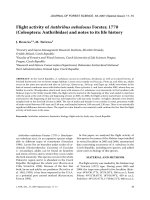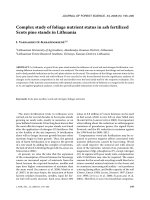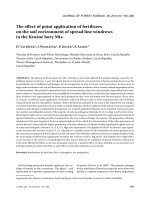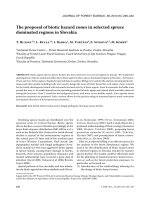Báo cáo lâm nghiệp: " Current state of beech bark necrotic disease in southern Poland" ppt
Bạn đang xem bản rút gọn của tài liệu. Xem và tải ngay bản đầy đủ của tài liệu tại đây (187.82 KB, 6 trang )
J. FOR. SCI., 54, 2008 (10): 459–464 459
JOURNAL OF FOREST SCIENCE, 54, 2008 (10): 459–464
In recent decades, the beech bark necrotic disease
has become a serious phytopathogenic, silvicultural,
and landscape-ecological problem in Europe. Locally,
this disease obtains the character of epiphytocia. It is
studied by many authors, e.g. in France (D
et al. 1980; P 1983), Germany (M,
E 2000; S, S 1983), Po-
land (M 1997; R et al. 1989), Austria
(S 1980), Slovakia (C, M 2001,
2002; M, C 2001, 2003), Ukraine (G
et al. 1995), Hungary (M, C 2005), former
Yugoslavia (L 1985), Romania (C, C
1997, 1998; C et al. 1996), and Bulgaria (R,
P 1996).
In this contribution, we present the current results of
the evaluation of the degree of the beech bark necrotic
disease in selected localities in Southern Poland. Be-
cause of the absence of analogical investigations in
Poland, these results are original and complete the
knowledge of this disease. e aim of this paper is to
compare the state of the beech bark necrotic disease in
Southern Poland and North Slovakia, and to monitor
the occurrence of biotical vectors of this disease and of
the parasitical fungi of the genus Nectria (Fr.) Fr.
MATERIAL AND METHODS
e beech bark necrotic disease was studied on
April, 17 and 19, 2007 in three selected localities
in Southern Poland, in the orographic complexes
Beskid Sądecki, Beskid Niski, and Bieszczady. e
localities are briefly characterised in Table 1.
e necrotic disease of beech stems in the mother
stand were evaluated using the classification scale by
Supported by the Scientific Grant Agency VEGA of the Ministry of Education of the Slovak Republic and Slovak Academy of
Sciences, Grant No. 2/7004/27.
Current state of beech bark necrotic disease
in Southern Poland
A. C, I. M
Institute of Forest Ecology of the Slovak Academy of Sciences, Zvolen, Slovakia
ABSTRACT: e degree of the beech bark necrotic disease was evaluated in three selected localities in southern
Poland, in different orographic complexes, Beskid Sądecki, Beskid Niski, and Bieszczady. e degree is expressed by
means of the stem necrotising index (I
SN
), crowns necrotising index (I
CN
), and whole tree necrotising index (I
NWT
). e
values of the indices laid in the following limits: I
SN
0.73–0.84%, I
CN
0.12%–0.51%, and I
NWT
0.84%–0.90%. e current
status of the beech necrotic disease in Southern Poland can be considered as favourable. e values of I
SN
recorded in
Southern Poland were lower by 30% than the average I
SN
for whole Slovakia. We also recorded the frequency of selected
insect pests (Bucculatrix ulmella Zeller, Cryptococcus fagi Bärensp., and Ectoedemia liebwerdella Zimm.), which act
in the beech stands as vectors of the necrotic disease. With C. fagi, we recorded a high frequency reaching even 100%.
In contrast, we did not at all observe the occurrence of B. ulmella and E. liebwerdella, which are common in the beech
stands in Slovakia, as well as in Hungary, Romania, and Bulgaria. In the localities studied, we recorded the occurrence
of two species of parasitic fungi of the genus Nectria (Fr.) Fr. causing the beech bark necrotic disease, viz. Nectria cos-
mariospora Ces et De Not. and N. galligena Bres. ex Strasser.
Keywords: beech; Fagus sylvatica L.; necrotic disease; stem; crown part; Southern Poland
460 J. FOR. SCI., 54, 2008 (10): 459–464
C and M (1997). e necrosis of the crown
(branches) was evaluated according to our original
classification scale (C et al. 2007).
By combination of both classification scales, we
obtained an original scale used for the evaluation of
the necrotic disease of whole trees (Table 2).
In order to characterise the whole vertical profile
of the stand, we evaluated 100 trees of 1
st
–5
th
age
class (according to Kraft) in each stand. e data
on the degree of stem necrotising were evaluated
by means of the index of the stem necrotising (I
SN
),
separately for each age class and generally for all
age classes together. In the same way, we evaluated
necrotising of crowns (index of crown necrotising
– I
CN
) and of whole trees (index of whole tree necro-
tising – I
NWT
). A methodical explication of the indi-
ces, which represent, as a matter of fact, the mean of
the recorded degrees of necrotising, was presented
earlier by C and M (1998).
For testing the significance of differences be-
tween individual localities in the necrotic disease
of crowns, stems, and whole trees, expressed by
indices of necrotisation, we used the Mann-Whitney
U test.
Simultaneously with the degree of necrosis, we
recorded the frequency of the occurrence of the se-
lected insect pests, which act as vectors of the fungi
from the genus Nectria (Fr.) Fr. ey were repre-
sented by two butterfly species, Bucculatrix ulmella
Zeller and Ectoedemia liebwerdella Zimm., and the
bark lice Cryptococcus fagi Bärensp. eir frequency
was recorded around the whole perimeter of each
stem, from its buttresses up to the height of 2 m.
We also registered the occurrence of phytopathog-
enous fungi of the genus Nectria (Fr.) Fr. causing the
tracheomycotic necrotic disease type of the beech.
In laboratory, the fungi were identified according to
the keys and papers by B and K-
(1986), Č et al. (1971), H et
al. (1995), M et al. (2000), M (1963), and
S and W (1994).
RESULTS AND DISCUSSION
e degrees of beech bark necrotising in three lo-
calities in Southern Poland characterised by indices
of stems (I
SN
), crowns (I
CN
), and whole trees (I
NWT
)
necrotising are given for each age class in Table 3. In
all localities, we observed an increase of the degree
of stems necrotising proportional to the worsening
sociological position of the tree in the stand. is
trend confirms the existence of relationship between
the necrotic disease of stems and sociological posi-
tion of stems, which was proved in a set of 6,579 trees
from 54 localities from the whole Slovakia (C,
M 2002). A similar trend was also observed with
the values of the crown necrotising index. On the
contrary, in the evaluation of the degree of whole tree
necrotising we did not record a similar increasing
trend of I
NWT
with the worsening of the sociological
position of the tree
.
Table 1. Basic characteristics of the individual localities
Characteristics Kiczera Przysłup Przelecz Zebrak
Orographic formation Beskid Sądecki Bieszczady Beskid Niski
Location
49°26'N 49°11'N 49°16'N
20°46'E 22°22'E 22°12'E
Exposition W S W
Altitude (m a.s.l.) 600 610 825
Average age (years) 70 70 100
Parent rock flysch flysch flysch
Stocking 0.8 0.6 0.4
Slope (°)
10–15 12 15–20
beech 80, fir 15, beech 80, spruce 10, beech 95, fir 3,
Tree composition (%) spruce 4, pine 1 fir 4, maple 6 spruce 1, maple 1
Table 2. Combination of degrees of stem and crown
necrotisation
Degree of stem
necrotisation
Degree of crown necrotisation
0 1 2 3
0 0 0 1 1
1 1 1 2 2
2 2 2 3 3
3 3 3 3 3
4 4 4 4 4
J. FOR. SCI., 54, 2008 (10): 459–464 461
e values of I
SN
presented in Table 3 are very
similar in all studied localities and ranged from
0.72 (locality Przysłup) to 0.84 (locality Kiczera).
e values of I
SN
recorded in Southern Poland are
approximately by 30% lower than the average value
for the whole Slovakia (I
SN
= 1.22), which was cal-
culated on the base of the data from 54 localities
in 33 orographic complexes. e values of I
NWT
are
even more similar and range from 0.84 (Kiczera and
Przysłup) to 0.90 (Przelecz Zebrak). In any case, we
did not record statistically significant differences
between the localities (P > 0.05). On the contrary, the
differences between I
CN
the values from individual
localities are larger (0.12–0.51) and are statistically
significant (P < 0.05).
e current state of the beech bark necrotic dis-
ease in the three studied localities in Southern Po-
land can be considered as favourable. Apart from the
indices of necrotising, it was also confirmed by the
values of the frequency of crowns, stems, and whole
trees necrotising in individual degrees of necrotising,
as given in Tables 4 to 6. e frequency of the stem
necrotising in degree 0 ranges from 31% (Kiczera
and Przelecz Zebrak) to 43% (Przysłup). If we pool
the frequency of necrotising in degree 0 with that in
degree 1, the values range from 88% (Kiczera) to 92%
(Przelecz Zebrak). It means that the frequency of
necrotising in degrees 3–4 is low and ranges from 2%
(Przelecz Zebrak) to 5% (Kiczera). e comparison of
the values from Tables 4–6 shows that the frequen-
cies of whole trees necrotising are very similar to
those of stems necrotising.
In Table 7, we compare the values of I
SN
from
three localities in Southern Poland with those from
three selected localities from North Slovakia. ese
locations we selected so as to have simultaneously
minimum distance from one another among the
Southern Polish localities. e comparison of locali-
ties pairs shows that the values are almost identical
in one case (Przysłup = 0.73 and Udava = 0.70), and
that the greatest difference is between the localities
Przelecz Zebrak (0.80) and Kačalová (1.50). Mann-
Whitney U test confirmed the statistical signifi-
cance of the I
SN
values between these two localities
(P < 0.05). ere are also considerable differences
between I
SN
values from Kiczera (0.84) and Bukový
les (1.14), but Mann-Whitney U test did not confirm
their statistical significance (P > 0.05).
e frequency of the selected biotical vectors of the
beech bark necrotic disease in the localities studied
is given in Table 8. e most frequent biotical vector
of this disease is the bark lice Cryptococcus fagi (Bä-
rensp.). e frequency of its occurrence in 40 locali-
ties in Slovakia was 2–100% and its occurrence was
Table 3. Index of necrotisation – I
CN
, I
SN
,
I
NWT
(mean ± standard error) of the evaluated parts of trees in individual tree classes (I
CN
– index of crown necrotisation, I
SN
– index of
stem necrotisation, I
NWT
– index of whole trees necrotisation)
Locality Evaluation part
Tree classes
1
st
2
nd
3
rd
4
th
5
th
1
st
–5
th
Kiczera
crown 0.17 ± 0.07 0.10 ± 0.05 0.00 ± 0.00 0.22 ± 0.15 0.25 ± 0.25 0.12 ± 0.03
A
stem 0.57 ± 0.09 0.76 ± 0.11 1.06 ± 0.19 1.33 ± 0.17 1.75 ± 0.48 0.84 ± 0.07
whole trees 0.57 ± 0.09 0.76 ± 0.11 1.06 ± 0.19 1.33 ± 0.17 1.75 ± 0.48 0.84 ± 0.07
Przysłup
crown 0.24 ± 0.12 0.17 ± 0.08 0.56 ± 0.22 0.63 ± 0.42 0.50 ± 0.50 0.33 ± 0.08
B
stem 0.57 ± 0.15 0.55 ± 0.11 0.96 ± 0.19 1.13 ± 0.13 1.25 ± 0.75 0.73 ± 0.08
whole trees 0.62 ± 0.16 0.64 ± 0.13 1.08 ± 0.22 1.38 ± 0.26 1.50 ± 0.96 0.84 ± 0.10
Przelecz Zebrak
crown 0.28 ± 0.09 0.77 ± 0.18 0.64 ± 0.15 0.57 ± 0.30 0.00 ± 0.00 0.51 ± 0.07
C
stem 0.55 ± 0.09 0.96 ± 0.12 0.96 ± 0.17 1.00 ± 0.22 1.00 ± 0.00 0.80 ± 0.07
whole trees 0.60 ± 0.10 1.12 ± 0.16 1.08 ± 0.19 1.14 ± 0.26 1.00 ± 0.00 0.90 ± 0.08
Statistical significance of differences in I
CN
, I
SN
,
I
NWT
of all tree classes between
localities is
marked by A, B and C
462 J. FOR. SCI., 54, 2008 (10): 459–464
recorded in each of these localities. A high frequency
of C. fagi was also observed in Southern Poland. Re-
markable is the absence of the butterfly Ectoedemia
liebwerdella Zimm., which was commonly observed
on the beech bark in Slovakia, Hungary, and Bul-
garia. It seems that this vector of the necrotic disease
has not passed the Carpathian representing a natural
barrier between Slovakia and Southern Poland. It is
illustrated by an old finding of E. liebwerdella at the
Jesienia locality, where it was discovered in 1947 by
A (in S 1958). is butter-
fly was found to occur commonly, with frequency
from 1–100%, in 23 among 40 localities in Slovakia
(M, C 2001). e possibility of a passive
transfer of the infectious agens of fungi of the genus
Nectria – on body of adult E. liebwerdella – was re-
corded by K and S (1999). Similarly, in
all three localities in Southern Poland we recorded
the absence of the butterfly Bucculatrix ulmella Zel-
ler. In Slovakia it occurred in 27 among 40 localities,
with the frequency of 1–91%.
During our investigation, we also recorded the
occurrence of two species of the genus Nectria (Fr.)
Fr. – the species Nectria cosmariospora Ces et De
Not. in the locality Przelecz Zebrak, and Nectria gal-
ligena Bres. ex Strasser in the localities Kiczera and
Przysłup. e species N. galligena Bres. ex Strasser
is generally considered to be a dangerous parasite
Table 4. Frequency of necrotisation of beech stem in selected localities
Locality
Frequency of necrotisation in necrotisation degrees (%)
0 1 2 3 4 1–4 2–4 3–4
Kiczera 31 57 9 3 0 69 12 3
Przysłup 43 47 5 4 1 57 10 5
Przelecz Zebrak 31 61 6 1 1 69 8 2
Table 5. Frequency of necrotisation of beech crown in selected localities
Locality
Frequency of necrotisation in necrotisation degrees (%)
0 1 2 3 1–3 2–3
Kiczera 88 12 0 0 12 0
Przysłup 82 9 3 6 18 9
Przelecz Zebrak 62 27 9 2 38 11
Table 6. Frequency of necrotisation of whole trees in selected localities
Locality
Frequency of necrotisation in necrotisation degrees (%)
0 1 2 3 4 1–4 2–4 3–4
Kiczera 31 57 9 3 0 69 12 3
Przysłup 41 45 7 3 4 59 14 7
Przelecz Zebrak 30 55 12 1 2 70 15 3
Table 7. Index of stem necrotisation on selected localities in border zone between Slovakia and Poland
Orographic formation Locality I
SN (1–5)
Orographic formation Locality I
SN (1–5)
Pieniny Bukový les 1.14 ± 0.12 Beskid Sądecki Kiczera 0.84 ± 0.07
Ondavská vrchovina Kačalová 1.50 ± 0.11
A
Beskid Niski Przelecz Zebrak 0.80 ± 0.07
B
Bukovské vrchy Udava 0.70 ± 0.10 Bieszczady Przysłup 0.73 ± 0.08
I
SN (1–5)
– index of stem necrotisation for 1
st
–5
th
tree classes
Statistical significance of differences in I
SN (1–5)
on selected localities in border zone of Slovakia
and Poland is
marked by A, B
Slovakia
Poland
J. FOR. SCI., 54, 2008 (10): 459–464 463
provoking the necrotic disease (S 1990). e
species N. galligena Bres. ex Strasser and Nectria
coccinea (Pers.) Fr. are considered to be common
fungi occurring in the beech bark necrotic disease in
Poland (G 1990). A bad-health state of the
beech stands in Bieszczady was observed in 1970s
and 1980s (R et al. 1989). e parasitical
complex C. fagi – N. coccinea is considered to be
especially dangerous for the beeches in Bieszczady
(R et al. 1989). e development of the root
decay and dying of naturally regenerated beeches
manifested by necroses were observed in western
and north-western Poland (M 1997).
R ef ere nce s
BREITENBACH J., KRÄNZLIN F., 1986. Ascomycetes. Fungi
in Switzerland. Vol. 1. Luzern, Verlag Mykologia: 412.
CHIRA D., CHIRA F., 1997. Beech canker spreading in Roma-
nia. In: KNÍŽEK M. et al. (eds), Workshop on Forest Insect
and Disease Survey. Proceedings. Písek: 46–53.
CHIRA D., CHIRA F.,
1998. Beech problems in Romania.
In: I.U.F.R.O. Workshop, Complex Diseases. Proceedings.
Wien: 23–28.
CHIRA F., CHIRA D., NEMTEANU P., VLADUTI S., 1996.
Beech canker (Nectria sp.) – a disease which continues to
spread. Revista de Silvicultura, 1: 25–29.
CICÁK A., MIHÁL I.,
1997. Metodika hodnotenia nekrotizácie
kôry kmeňov buka. Lesnictví-Forestry, 43: 104–110.
CICÁK A., MIHÁL I.,
1998. Index nekrotizácie kôry kmeňov
buka. Lesnictví-Forestry, 44: 474–477.
CICÁK A., MIHÁL I., 2001. Tracheomycotic disease
symptoms on beech trees. Mikologija i fitopatologija,
35:
54–61.
CICÁK A., MIHÁL I., 2002. State of necrotic disease of
beech stands in Slovakia. Mikologija i fitopatologija, 36:
93–105.
CICÁK A., MIHÁL I., TSAKOV H., PETKOV P., 2007. Meth
-
ods of complex evaluation of the necrotic disease of beech.
Journal of Forest Science, 53: 462–466.
ČERVENKA M.
et al., 1971. Kľúč na určovanie výtrusných
rastlín. Slizovky a huby. II. časť. Bratislava, SPN: 392.
DECOURT N., MALPHETTES C.B., PERRIN R., CARON D.,
1980. La pollution soufrée limite-t-elle le développement de
la maladie de l’écorce du hêtre (Cryptococcus fagi, Nectria
coccinea)? Annales des Sciences Forestière, 37: 135–145.
GAJEVAJA V.P., ISIKOV V.P., MEREZHKO T.A., DUDKA
I.A., 1995. Xylotrofičeskaja mykobiota buka na Ukraine.
Mikologija i fitopatologija,
29: 96–97.
GRZYWACZ A., 1990. Waźniejsze choroby infekcyjne. In:
BIAŁOBOK S. (ed.), Buk zwyczajny – Fagus sylvatica L.
Nasze drzewa lesne, Monografie popularnonaukowe. Tom
10. Warszawa, Poznań, PAN: 525–554.
HARTMANN G., NIENHAUS F., BUTIN H., 1995. Farbatlas
Waldschäden – Diagnose von Baumkrankheiten. Stuttgart,
Eugen Ulmer Verlag: 288.
KODRÍK J., SUVÁK M., 1999. Málo známy motýlik
Ecto-
edemia liebwerdella Zimmerm. rozšírený v bučinách
Slovenska. Les, 55: 22–23.
LAZAREV V.,
1985. Bolesti kore bukve u izdanačkim sumama.
Zaštita bilja, 36: 195–201.
MAŃKA M., 1997. Broadleaved tree transplants dieback
in spring 1997 in Poland. Phytopathologia Polonica, 13:
150–151.
METZLER B., VON ERFFA R., 2000. Zur Verbreitung von
Buchenkrebs in Naturverjüngungen in Baden-Württem-
berg – Einfluss von Überschormung und Standortsfaktoren.
Forstwissenschaftliches Centralblatt, 119: 297–309.
MIHÁL I., CICÁK A., 2001. Biotic vectors of beech necrotic
disease of the tracheomycotic type. Ekológia (Bratislava),
20: 404–413.
MIHÁL I., CICÁK A., 2003. State of necrotic disease of beech
in the growth phase of natural seeding in Slovakia. Ekológia
(Bratislava), 22: 42–50.
MIHÁL I., CICÁK A., 2005. State of beech bark necrotic
disease in northern Hungary. Lesnícky časopis – Forestry
Journal, 51: 55–60.
MIHÁL I., CICÁK A., JUHÁSOVÁ G., IVANOVÁ H., 2000.
Huby rodu Nectria ako pôvodcovia nekrotického ochorenia
kôry buka. Folia Oecologica, 27: 189–196.
MOSER M., 1963. Ascomycetes. Kleine Kryptogamenflora.
Band IIa. Jena, VEB Gustav Fischer Verlag: 136.
PERRIN R., 1983. Current status of beech bark disease in
France. In: Beech Bark Disease Working Party Conference,
Table 8. Frequency of occurrence (%) of biotic vectors of beech necrotic disease on selected localities in Poland
Locality
Altitude
(m a.s.l.)
Cryptococcus fagi Bucculatrix ulmella
Ectoedemia
liebwerdella
Kiczera 600 100 0.0 0.0
Przysłup 610 99 0.0 0.0
Przelecz Zebrak 825 100 0.0 0.0
Bucculatrix ulmella Zeller – pupae, Cryptococcus fagi Bärensp. – colonies of adult individuals, Ectoedemia liebwerdella
Zimm. – galleries in bark after mining
464 J. FOR. SCI., 54, 2008 (10): 459–464
I.U.F.R.O. Proceedings, September 26–October 8, 1982.
USDA Forest Service, Hamden, Connecticut: 7–9.
ROSNEV B., PETKOV P., 1996. Zdravoslovno sostojanje na
buka (Fagus sylvatica L.) v sredna i istočna Stara planina.
In: Study, Conservation and Utilisation of Forest Resources.
Proceedings, Vol. II., 3.–5. June 1996. Sofia: 156–160.
RYKOWSKI K., OSZAKO T., SIEROTA Z., 1989. Zagroźenie
buka w Bieszczadach. Las Polski, 6: 5–8.
SCHIMITSCHEK E., 1980. Cryptococcus fagi Bärensp. und
die Buchen-Rindennekrose. Anzeiger für Schädlingskunde,
Pflanzenschutz und Umweltschutz, 53: 97–98.
SCHÖNHERR J., 1958. Biologie und Morphologie von Ecto-
edemia liebwerdella Zimmerm., unter Berücksichtigung
der übrigen rindenminierenden Nepticuliden. Deutsche
Entomologische Zeitschrift, 5: 1–71.
SCHÜTT P., SUMMERER H., 1983. Waldsterben – Symp-
tome an Buche. Forstwissenschaftliches Centralblatt, 102:
201–206.
STROUTS R.G., WINTER T.G., 1994. Diagnosis of ill – health
in trees. Research for Amenity Trees. Forestry Commission,
HMSO: 307.
SUROVEC D., 1990. Príznaky a príčiny chradnutia mladých
bučín na Slovensku. Les, 46: 12–14.
Received for publication May 23, 2008
Accepted after corrections July 17, 2008
Corresponding author:
Ing. A C, CSc., Ústav ekológie lesa SAV, Štúrova 2, 960 53 Zvolen, Slovensko
tel.: + 421 455 330 914, fax: + 421 455 479 485, e-mail:
Aktuálny stav nekrotického ochorenia kôry buka v južnom Poľsku
ABSTRAKT: V príspevku uvádzame aktuálne výsledky hodnotenia stupňa nekrotického ochorenia buka na troch
vybraných lokalitách v južnom Poľsku, v orografických celkoch Beskid Sądecki, Beskid Niski a Bieszczady. Výsledky
uvádzame formou indexu nekrotizácie kmeňov buka (I
NK
), indexu nekrotizácie korún (I
NKR
) ako aj indexu nekro-
tizácie celých stromov (I
NCS
). Hodnoty indexov sa pohybovali v rozpätí: I
NK
od 0,73 % do 0,84 %, I
NKR
od 0,12 % do
0,51 % a I
NCS
od 0,84 % do 0,90 %. Stav nekrotického poškodenia buka na troch lokalitách v južnom Poľsku môžeme
pokladať za priaznivý. Hodnoty I
NK
zistené v južnom Poľsku sú až o 30 % nižšie ako priemerná hodnota I
NK
za celé
Slovensko. Zaznamenávali sme aj frekvenciu výskytu vybraných hmyzích škodcov (Bucculatrix ulmella Zeller, Cryp-
tococcus fagi Bärensp. a Ectoedemia liebwerdella Zimm.), ktorí v bukových porastoch pôsobia ako vektory nekrotic-
kého ochorenia buka. Vysokú, až 100% frekvenciu výskytu sme zistili u druhu C. fagi. Naopak nezistili sme žiadny
výskyt druhov B. ulmella a E. liebwerdella, ktoré sa bežne vyskytovali v bučinách na Slovensku ako aj v Maďarsku,
Rumunsku a Bulharsku. Na sledovaných lokalitách sme zaznamenali výskyt dvoch druhov parazitických húb rodu
Nectria (Fr.) Fr., spôsobujúcich nekrotické ochorenie buka. Boli to druhy Nectria cosmariospora Ces et De Not. a N.
galligena Bres. ex Strasser.
Kľúčové slová: buk; Fagus sylvatica L.; nekrotické ochorenie; kmeň; korunová časť; južné Poľsko









